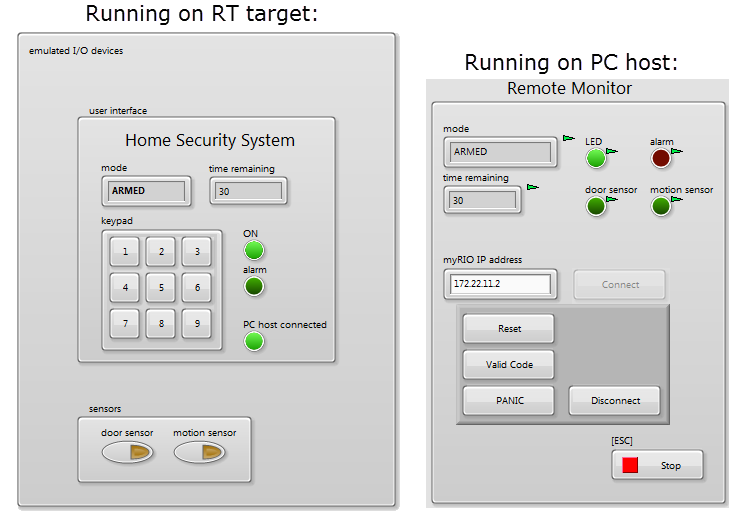RIO Developer Essentials Guide for Academia
"Inter-process" communication
RT inter-process communication
RT guide
Exchange data between process loops running in parallel on the RT target.
Local variable (RT)
RT code
Use a local variable (front-panel indicator) to communicate between two parallel process loops contained within the same VI, and use a local variable to stop parallel loops with one "stop" button.
Global variable (RT)
RT code
Use a global variable to communicate between two parallel process loops contained within different VIs under the same target, and use a global variable to stop parallel loops with one "stop" button.
A single-process shared variable (SPSV) behaves like a global variable that links deterministic and non-deterministic process loops, effectively shielding the deterministic loop from elements that contribute jitter.
Functional global variable (FGV)
RT code
Use a functional global variable (FGV) to communicate between two parallel process loops contained within different VIs under the same target, and use a FGV to stop parallel loops with one "stop" button. The "functional" nature of the FGV means that you can create additional functionality beyond that of a basic global variable, e.g., counting and calculations that operate on the stored value.
Queue
RT code
Use a queue to send messages and data between two or more parallel process loops contained within a VI or other VIs. Queues also serve as the foundation for the "Queued State Machine" design pattern.
Channel wire
RT code
Use a channel wire to communicate between two (or more) parallel process loops contained within the same VI, and use a channel wire to stop parallel loops with one "stop" button. Requires LabVIEW 2016 or later version.
FPGA inter-process communication
RT guide
Exchange data between process loops running in parallel on the RT target.
Local variable (FPGA)
FPGA code
Use a local variable (front-panel indicator) to communicate between two parallel process loops contained within the same VI.
Global variable (FPGA)
FPGA code
Use a global variable to communicate between two parallel process loops contained within different VIs under the same target.
Queued state machine
RT code
State machines perform system control, data processing, and any task that involves executing a sequence of activities in response to inputs from the surrounding physical system, the user interface, and other processes within the system. The queued state machine is a particular implementation style that is flexible and versatile, easy to maintain, and computationally efficient.
The queued message handler contains multiple process loops operating independently and in parallel that communicate with each other by sending messages through queues. Each process is a well-defined task implemented by the "Queued State Machine" design pattern. Breaking up the system into self-contained tasks greatly simplifies the design of complex systems.
System controller application example: Home Security System
RT code PC code
Example of a complete RT system controller based on the Queued Message Handler (QMH) design pattern with multiple parallel task loops implementing behaviors with queued state machines (QSMs), various inter-process communication techniques (queues and local variables), and inter-target communication techniques (network-published shared variables (NPSVs) and network streams). The PC host human-machine interface (HMI) can remotely connect to the system through the network, monitor the status of the security system, and control it remotely.
Create a responsive user interface based on two loops operating in parallel: the "producer" loop event structure responds immediately to user interactions such as button clicks and mouse movements that send commands through a queue to the "consumer" loop which performs the required tasks. Separating the state machine into two loops allows the user interface to remain responsive should a consumer task require an unusual amount of time or must wait for a shared resource to become available.













